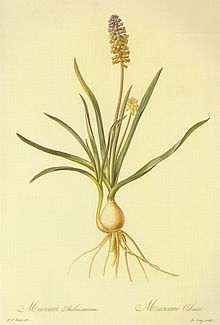Muscari racemosum
Muscari racemosum | |
|---|---|
 | |
Scientific classification | |
| Kingdom: | Plantae |
Clade: | Angiosperms |
Clade: | Monocots |
| Order: | Asparagales |
| Family: | Asparagaceae |
| Subfamily: | Scilloideae |
| Genus: | Muscari |
| Species: | M. racemosum |
Binomial name | |
Muscari racemosum Mill. | |
Synonyms[1] | |
| |
Muscari racemosum is a perennial bulbous plant, one of a number of species and genera known as grape hyacinth. Originally from south-west Turkey where it grows in rocky places, it is sometimes grown as an ornamental plant. It may be found in the horticultural literature under the synonym Muscari muscarimi.[2]
M. racemosum resembles M. macrocarpum (with which it has been placed in the Muscarimia group of the genus Muscari). It is a robust plant, with large bulbs which have thick fleshy roots. Each bulb produces several greyish-green leaves. Flowers are borne in a spike or raceme. Individual flowers are 7–9 mm long, grey-white when fully open, sometimes with a bluish tone; they have a distinct scent of musk.[2] This is the species from which the genus gets its name (Muscari is from the Greek muschos, meaning musk).[3]
References
^ WCSP (2011), World Checklist of Selected Plant Families, The Board of Trustees of the Royal Botanic Gardens, Kew, retrieved 2011-11-14.mw-parser-output cite.citation{font-style:inherit}.mw-parser-output q{quotes:"""""""'""'"}.mw-parser-output code.cs1-code{color:inherit;background:inherit;border:inherit;padding:inherit}.mw-parser-output .cs1-lock-free a{background:url("//upload.wikimedia.org/wikipedia/commons/thumb/6/65/Lock-green.svg/9px-Lock-green.svg.png")no-repeat;background-position:right .1em center}.mw-parser-output .cs1-lock-limited a,.mw-parser-output .cs1-lock-registration a{background:url("//upload.wikimedia.org/wikipedia/commons/thumb/d/d6/Lock-gray-alt-2.svg/9px-Lock-gray-alt-2.svg.png")no-repeat;background-position:right .1em center}.mw-parser-output .cs1-lock-subscription a{background:url("//upload.wikimedia.org/wikipedia/commons/thumb/a/aa/Lock-red-alt-2.svg/9px-Lock-red-alt-2.svg.png")no-repeat;background-position:right .1em center}.mw-parser-output .cs1-subscription,.mw-parser-output .cs1-registration{color:#555}.mw-parser-output .cs1-subscription span,.mw-parser-output .cs1-registration span{border-bottom:1px dotted;cursor:help}.mw-parser-output .cs1-hidden-error{display:none;font-size:100%}.mw-parser-output .cs1-visible-error{font-size:100%}.mw-parser-output .cs1-subscription,.mw-parser-output .cs1-registration,.mw-parser-output .cs1-format{font-size:95%}.mw-parser-output .cs1-kern-left,.mw-parser-output .cs1-kern-wl-left{padding-left:0.2em}.mw-parser-output .cs1-kern-right,.mw-parser-output .cs1-kern-wl-right{padding-right:0.2em}, search for "Muscari racemosum"
^ ab Mathew, Brian (1987), The Smaller Bulbs, London: B.T. Batsford, ISBN 978-0-7134-4922-8, p. 130 (under the name M. muscarimi)
^ Garbari, F. & Greuter, W. (1970), "On the Taxonomy and Typification of Muscari Miller (Liliaceae) and Allied Genera, and on the Typification of Generic Names", Taxon, 19 (3): 329–335, doi:10.2307/1219056